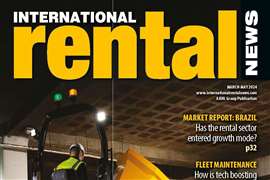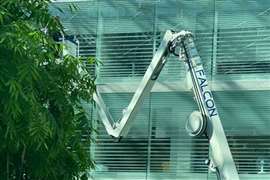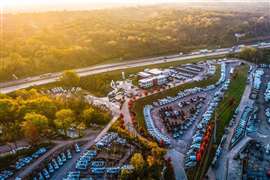Growth boost
19 March 2008
The Brazilian Government's BRL 504 billion (US$ 257 billion) Growth Acceleration Plan (PAC) aims to renew investment in the country's roads, ports, airports, housing, energy and sanitation sectors in a bid to accelerate economic growth. Richard High reports.
Announcing Brazil's latest infrastructure initiative, the PAC, in January this year President Lula said the initiative was designed to “unlock” the country's economy and boost its growth rate from the average of +2.6% seen since 2000, to +5% by 2010.
According to Roberta Primasi, marketing manager at Brazilian consulting engineering company Proficenter Planjamento de Obras, the PAC is a strategic program of investment that will expand the country's infrastructure. Profilcenter, which specialises in the preparation of technical and commercial proposals for construction, infrastructure and public service concessions, told iC the Government has earmarked US$ 128.4 billion for the energy sector, US$ 27.2 billion for transport, US$ 79.8 billion for housing and sewage and will also develop several “projects of social inclusion”.
About 55% (US$ 70.6 billion) of the energy investments, said Ms Primasi, are destined for projects in the gas and petroleum sectors. The rest will be invested in power generation (hydroelectric) and the development of renewable energy sources such as ethanol and bio-diesel.
Investments in the transport sector will focus on the construction and rehabilitation of more than 42000 km of highway (US$ 17 billion), 2518 km of railroad tracks (US$ 4 billion), 20 airports (US$ 1.5 billion), 12 marine ports, and 67 river ports (US$ 1.4 billion).
Only part financed by the Government (US$ 31.7 billion), it is hoped the rest, US$ 204 billion, will come from state owned companies and the private sector.
Many of these projects will use Public Private Partnerships PPP) as the finance model. The state Government of Minas Gerais, for example, is planning to develop PPP projects to repair about 6000 km of state highways.
These plans have benefited from the successful start of the MG-050 highway PPP project, which recently became Brazil's. first PPP highway transport scheme to get of the ground.
The Bertin-Equipava consortium has started repair and expansion work on the MG-050 and will invest US$ 370 million in the highway during its 25-year repair and operation concession.
Economic booster
The US Association of Equipment Manufacturers (AEM) reports that many of the PAC's transport sector projects are aimed at Brazil's non-residential sector is also undergoing expansion facilitating the export of mining and agricultural products, the staples of Brazil's exports. Investment in this sector, thanks to the huge global demand at present for basic commodities, such as iron ore, has been considerable.
And that investment doesn't look like stopping in the short term.
Mining company Bahia Mineração (BML) recently announced plans to build a US$ 1.6 billion iron ore complex in the northeast state of Bahia, an iron ore mine and concentration plant and a 400 km ore pipeline in addition to a port facility. The project could create more than 1000 direct and 8000 indirect jobs once it hits full operations, said BML.
PPP also looks like playing a large part in the expansion of the country's rail sector.
Logistics company ALL, for example, is considering investment in three major projects in the south of the country using PPP, said company president Bernardo Hees in March this year.
These include part of the Guarapuava to Ipiranga rail line in Paran&225; state (US$ 274 million), itself part of the PAC, the Porto Alegre-Pelotas rail line in Rio Grande do Sul state (US$ 283 million), and a rail ring around the Paraná state capital of Curitiba (US$ 70 million).
For its part the Government has created a US$ 5.3 billion infrastructure fund to boost regional development. Financed by taking 2% of existing income tax and industrialised products tax it will split the country into four sectors, with funds being assigned appropriately for a particular area's needs.
Projects aided by the fund, PPP and private investment, according to the AEM's Advisor Latin America June 2007 report, a would provide an economic booster to local construction sectors due to their “multiplier effect” in the overall sector.
Sector growth According to the Brazilian Construction Industry Chamber (CBIC) the construction sector could grow between +8 to +9% this year. GDP in the construction sector could increase by an additional +1.5% annually throughout 2010 if all projects under the PAC program are completed, said a CBIC statement.
The effect of the PAC will also be felt in the cement sector, according to the National Cement Industry Union (SNIC). It is expected to grow by +5% this year, with consumption expected to reach 42 million tonnes this year, compared to 39.5 million tonnes in 2006.
Brazil's per capita cement consumption is about 190 kg/person annually as compared to 800 kg in China. Brazil has a production capacity of 62 million tonnes annually.
The construction equipment market may get a boost this year too. The recent government announcement to exempt companies investing in infrastructure from various taxes aims to promote investments in the PAC by exempting companies from paying PIS (social integration program) and Confins (social security contributions) taxes.
However, investments in PAC are already behind schedule, according to Paulo Bernardo, the Planning Minister. Speaking in March this year he said PAC investments in the first quarter of 2007 totaled BRL 2 billion (US$ 1.08 billion) and were unlikely to reach the target of BRL 15 billion (US$ 8.2 billion).
Others have also questioned whether all the projects will be completed by 2010. According to José Luiz Alquéres, vice president of infrastructure and basic industries association, Abdib, less than 40% of the infrastructure projects outlined under PAC will come to fruition.
The announcement follows an analysis by 25 Abdib members of the projects cited in the program that have the best chance of going ahead. “Each one evaluated the list of projects in its area and estimated which have a chance of going ahead and which do not. In this way, we arrived at the figure of 40% [of the projects] which are expected to go ahead,” said Mr Alquéres.
Outlook
There is no doubt the Brazilian Government is committed to securing economic growth through infrastructure expansion. But, it remains to be seen whether funding for all the projects will be forthcoming.
However, the growth in PPP, and the continued private investment in industry should mean the PAC has a fighting chance of achieving its aims.
All good news for contractors and equipment manufacturers alike.






